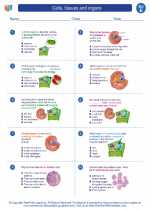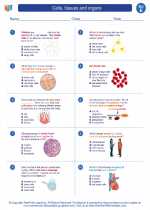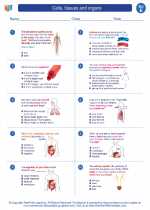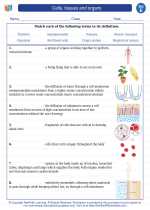Cells, tissues and organs -> meiosis
Meiosis
Meiosis is a type of cell division that occurs in sexually reproducing organisms. It is a crucial process for producing gametes (sperm and egg cells) with half the number of chromosomes found in somatic cells. This reduction in chromosome number is essential for maintaining the correct number of chromosomes in the offspring and promoting genetic diversity.
Phases of Meiosis
Meiosis consists of two consecutive cell divisions, known as meiosis I and meiosis II. Each of these divisions is further divided into specific phases:
Meiosis I
- Prophase I: Chromosomes condense, homologous chromosomes pair up in a process called synapsis, and genetic recombination occurs through crossing over.
- Metaphase I: Homologous pairs line up at the cell's equator, with spindle fibers attaching to each chromosome.
- Anaphase I: Homologous chromosomes separate and move towards opposite poles of the cell.
- Telophase I: Chromosomes reach the poles, and the cell undergoes cytokinesis, resulting in two haploid daughter cells.
Meiosis II
- Prophase II: A new spindle forms in each haploid daughter cell.
- Metaphase II: Chromosomes line up at the cell's equator.
- Anaphase II: Sister chromatids separate and move towards opposite poles of the cell.
- Telophase II: Chromosomes reach the poles again, and the cells undergo cytokinesis, resulting in a total of four haploid daughter cells, each with a unique combination of genes.
Significance of Meiosis
Meiosis plays a crucial role in sexual reproduction, as it ensures genetic diversity in offspring by creating gametes with different combinations of genetic material. It also helps in maintaining a constant number of chromosomes in a species across generations.
Study Guide
When studying meiosis, it's important to focus on the following key concepts:
- Understand the differences between meiosis and mitosis.
- Learn the specific stages of meiosis I and meiosis II, including the events that occur during each phase.
- Explore the significance of genetic recombination and crossing over during prophase I.
- Understand the importance of meiosis in generating genetic diversity and maintaining chromosome number stability in sexually reproducing organisms.
It can also be helpful to use visual aids such as diagrams or animations to understand the spatial and temporal aspects of meiosis.
For practice, consider using meiosis worksheets or interactive online quizzes to test your understanding of the process.
Remember to review and reinforce your knowledge of meiosis regularly to ensure a strong grasp of this fundamental biological process.
.◂Science Worksheets and Study Guides Fifth Grade. Cells, tissues and organs

 Worksheet/Answer key
Worksheet/Answer key
 Worksheet/Answer key
Worksheet/Answer key
 Worksheet/Answer key
Worksheet/Answer key
 Vocabulary/Answer key
Vocabulary/Answer key
 Vocabulary/Answer key
Vocabulary/Answer key
 Vocabulary/Answer key
Vocabulary/Answer key
 Vocabulary/Answer key
Vocabulary/Answer key
 Vocabulary/Answer key
Vocabulary/Answer key
 Vocabulary/Answer key
Vocabulary/Answer key
